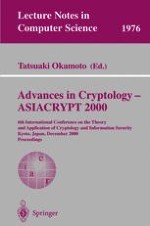ASIACRYPT 2000 was the sixth annual ASIACRYPT conference. It was sp- sored by the International Association for Cryptologic Research (IACR) in - operation with the Institute of Electronics, Information, and Communication Engineers (IEICE). The ?rst conference with the name ASIACRYPT took place in 1991, and the series of ASIACRYPT conferences were held in 1994, 1996, 1998, and 1999, in cooperation with IACR. ASIACRYPT 2000 was the ?rst conference in the series to be sponsored by IACR. The conference received 140 submissions (1 submission was withdrawn by the authors later), and the program committee selected 45 of these for presen- tion. Extended abstracts of the revised versions of these papers are included in these proceedings. The program also included two invited lectures by Thomas Berson (Cryptography Everywhere: IACR Distinguished Lecture) and Hideki Imai (CRYPTREC Project – Cryptographic Evaluation Project for the Japanese Electronic Government). Abstracts of these talks are included in these proce- ings. The conference program also included its traditional “rump session” of short, informal or impromptu presentations, kindly chaired by Moti Yung. Those p- sentations are not re?ected in these proceedings. The selection of the program was a challenging task as many high quality submissions were received. The program committee worked very hard to evaluate the papers with respect to quality, originality, and relevance to cryptography. I am extremely grateful to the program committee members for their en- mous investment of time and e?ort in the di?cult and delicate process of review and selection.
